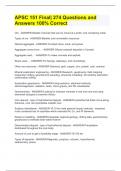APSC 151 Final| 274 Questions and Answers 100% Correct
Ore - ANSWER-Metallic minerals that can be mined at a profit, rock containing metal
Types of ore - ANSWER-Metallic and nonmetallic resources
Natural aggregate - ANSWER-Crushed stone, sand, and gravel
Aggregate comes from... - ANSWER-Glacial outwash deposits in Canada
Aggregate used... - ANSWER-To make concrete and asphalt
Stone used... - ANSWER-For facings, walkways, and countertops
Other ore resources - ANSWER-Diamond, gold, copper, zinc, potash, coal, uranium
Mineral exploration engineering - ANSWER-Research, geophysics, field mapping, exploration drilling, geochemical sampling, structural modelling, 3D orebody estimation, confirmation drilling
Exploration geophysics - ANSWER-Using seismics, electrical methods, electromagnetism, radiation, radar, micro-gravity, and 3D visualization
Geochemistry - ANSWER-Looking for indicator minerals in soil and rock and using elemental isotopes to examine history
Vein deposit - type of hydrothermal deposit - ANSWER-Hydrothermal fluids move along fractures, cool, and precipitate metallic ions
Sudbury Astrobleme - ANSWER-10-15 km wide asteroid impact orebody - impacted rocks contained lots of sulphides which extracted Ni, Cu, and Pt elements
Reserve modelling - ANSWER-Integrates regional geology, drilling data, geochemistry, geophysics to estimate total viable reserve
Disseminated deposit - type of hydrothermal deposit - ANSWER-Precipitation distributed throughout the rock body
Amount of core to get to feasibility stage - ANSWER-75-150 km
Types of deposits - ANSWER-Magmatic, porphyry, volcanic, hydrothermal, sedimentary, placer Magmatic deposits - ANSWER-Some metals enriched and concentrated during magma cooling, heavy minerals crystallize early and concentrate at bottom of magma chamber (e.g. chromite, iron, magnetite)
Porphyry orebodies - ANSWER-Magmatic and hydrothermal (hot water) - form as liquid and gas volatiles change chemical state and change saturation limit for sulphide minerals
Copper porphyry - ANSWER-Cyclical magmatic intrusion with alteration by volcanic waters
Volcanic deposits - ANSWER-Violent kimberlite eruptions bringing diamonds from upper
mantle to surface
Epithermal volcanic deposits - ANSWER-Near surface deposits precipitated from hot volcanic waters
What causes different ore types? - ANSWER-Interaction with temperature, pressure, volatile gases, and solution as magma rises
Hydrothermal deposits associated with igneous activity - ANSWER-Hot groundwater dissolves metals in the presence of salts and hydrothermal fluids move along fractures, cool, and deposit them as orebodies
Black smokers - type of hydrothermal deposit - ANSWER-Seawater gushes from seafloor near spreading centres and precipitates volcanogenic massive sulphide deposits - deformed by tectonics
Sedimentary deposits - ANSWER-During development of Earth's atmosphere, oxygen reacted with iron dissolved in seawater and caused it to precipitate on seafloor
Placer deposits - ANSWER-Any deposit that accumulates in loose form due to sedimentation or where ore has been eroded from one primary source to be further concentrated and redeposited elsewhere
Mining - ANSWER-Extracting essential natural resources locked in crustal rock
Mineral resource - ANSWER-Elements, compounds, minerals, or rocks concentrated in a form that can be extracted to obtain a useable commodity
Ore reserve - ANSWER-Confirmed portion of resource that can be extracted at a profit
Exploration for making a reserve - ANSWER-Confirmation drilling and assaying (quantifying amount of metal accessible) Smelting - ANSWER-Extracting metal from ore using heat and melting
Overburden - type of mine waste - ANSWER-Material above orebody
Waste rock - type of mine wate - ANSWER-Barren part of orebody
Tailings - type of mine waste - ANSWER-Silt sized waste from grinding
Slag - type of mine waste - ANSWER-Waste from smelting
Other type of mine waste - ANSWER-Chemical waste
Open pit mining - ANSWER-Removing lots of waste and material to get at orebody
Rock quality - ANSWER-Weak rock can be excavated mechanically, strong rock must be blasted
Excavation methods - ANSWER-Pit blasting and open pit haulage
Modern underground mines - ANSWER-Extremely complex geometry
Aspects of a mine - ANSWER-Shaft, ventilation, hoist, garage, machine shop, crusher, drills
Longwall mining - ANSWER-Mining along a wall
Room and pillar - ANSWER-Mine everything except support pillars
Sublevel mining - ANSWER-Drill/blast at different levels and then collect it at the bottom
Vein mining - ANSWER-Very narrow mining
Cut and fill mining - ANSWER-Fill what's removed with more material
Vertical crater retreat (VCR) / Vertical retreat mining (VRM) - ANSWER-Vertically drilling
large-diameter holes into the orebody from the top, and then blasting horizontal slices of
the orebody into an undercut
Block caving - ANSWER-Blast enough space that the orebody starts to fail or cave
Mass wasting - ANSWER-The downslope movement of rock and soil under the direct influence of gravity
Role of mass wasting - ANSWER-Geologic process that often follows weathering, combined effects of mass wasting and running water (erosion) produce stream valleys




